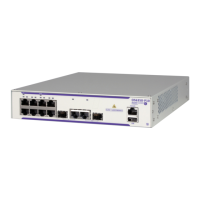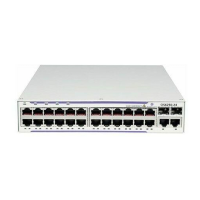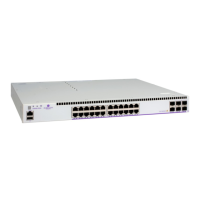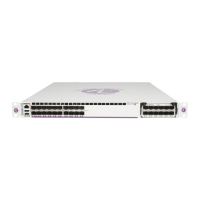Configuring VLAN Stacking Configuring VLAN Stacking Services
OmniSwitch AOS Release 8 Network Configuration Guide December 2017 page 35-16
Use the show ethernet-service sap command to display the SAPs configured for the switch. Use the
show ethernet-service command to display a list of VLAN Stacking services and the SAPs associated
with each service.
Configuring VLAN Stacking User Ports
The ethernet-service sap uni command is used to configure a switch port or a link aggregate as a VLAN
Stacking User Network Interface (UNI) and associate the UNI with a VLAN Stacking service access point
(SAP). For example, the following command configures port 1/1 as an UNI port and associates 1/1 with
SAP 20:
-> ethernet-service sap 20 uni port 1/1
A UNI port is a customer-facing port on which traffic enters the VLAN Stacking service. When the port is
associated with a service access point, the port is automatically defined as a UNI port and the default
VLAN for the port is changed to a VLAN that is reserved for the VLAN Stacking application.
To delete a UNI port association with a VLAN Stacking SAP, use the no form of the ethernet-service sap
uni command. For example, the following command deletes the association between UNI 1/1 and SAP
20:
-> no ethernet-service sap 20 uni port 1/1
Note that when the last SAP association for the port is deleted, the port automatically reverts back to a
conventional switch port and is no longer VLAN Stacking capable.
Consider the following when configuring VLAN Stacking UNI ports:
• All customer traffic received on the UNI port is dropped until customer VLANs (CVLAN) are
associated with the port. See “Configuring the Type of Customer Traffic to Tunnel” on page 35-16.
• A default UNI profile is assigned to the port at the time the port is configured. This profile defines how
control frames received on the UNI ports are processed.
• To use different profile attribute values, create a new profile and associate it with the UNI port. See
“Configuring a UNI Profile” on page 35-19. Each time a profile is assigned to a UNI, the existing
profile is overwritten with the new one.
• Only fixed ports can be converted to UNI ports.
Use the show ethernet-service uni command to display a list of UNI ports and the profile association for
each port.
Configuring the Type of Customer Traffic to Tunnel
The ethernet-service sap cvlan command is used to associate customer traffic with a VLAN Stacking
service access point (SAP). This identifies the type of customer traffic received on the SAP UNI ports that
the service will process and tunnel through the SVLAN configured for the service. For example, the
following command specifies that traffic tagged with customer VLAN (CVLAN) 500 is allowed on UNI
ports associated with SAP 20:
-> ethernet-service sap 20 cvlan 500
In this example, customer frames tagged with VLAN ID 500 that are received on SAP 20 UNI ports are
processed by the service to which SAP 20 is associated. This includes applying profile attributes

